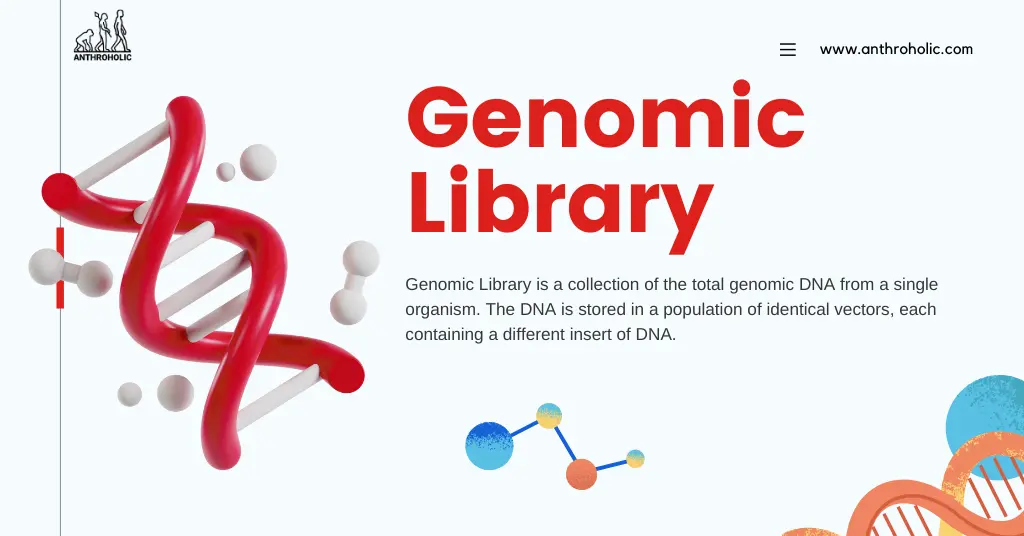AI Answer Evaluation Platform Live Now. Try Free Answer Evaluation Now
Genomic Library
Genomic Library is a collection of the total genomic DNA from a single organism. The DNA is stored in a population of identical vectors, each containing a different insert of DNA. These libraries serve as a lasting and comprehensive resource of the genomic information of that organism and can be used to clone and isolate any gene of interest.

Understanding the structure and function of the Genomic Library has been crucial for the progress of genomics, contributing to significant scientific milestones, such as the Human Genome Project [2]. Genomic Library provides an invaluable tool for researchers, enabling the identification, sequencing, and manipulation of genes in an organism’s genome [3].
Types of Genomic Library
Genomic Library is a collection of DNA fragments that collectively represent the genome of an organism. There are primarily two types of genomic Library, namely, DNA Library and cDNA Library, each with distinct characteristics and uses.
DNA Library
DNA Library, or genomic DNA Library, contain large fragments of DNA in a suitable vector. These libraries are constructed by fragmenting the genomic DNA of an organism and then cloning those fragments into a vector, usually a bacteriophage or plasmid. The fragmented DNA represents all of the coding (exons) and non-coding regions (introns, promoters, etc.) of the genome, providing a complete representation of the organism’s genetic information. This makes the DNA Library useful in genome mapping, comparative genomics, and identifying non-coding functional elements.
cDNA Library
cDNA Library are created from mRNA transcripts of an organism. The mRNA is reverse transcribed into complementary DNA (cDNA), which is then inserted into a cloning vector. As cDNA Library are derived from mRNA, they only represent the genes that are being actively transcribed in the cells at the time of extraction (Brown, 2002). These libraries are particularly useful in studying gene expression, protein coding sequences, and for the production of recombinant proteins.
Yeast Artificial Chromosomes (YACs) and Bacterial Artificial Chromosomes (BACs)
In addition to these main types of Library, there are also yeast artificial chromosomes (YAC) and bacterial artificial chromosome (BAC) Library, which are used to clone large fragments of DNA. BACs are often used in genome sequencing projects due to their ability to stably maintain large inserts of DNA (Shizuya et al., 1992). YACs, while they can contain even larger DNA fragments than BACs, may have more issues with stability and chimerism (Burke et al., 1987).
Creation of a Genomic Library
Selecting the Source of Genomic DNA
The first step in creating a genomic library is to obtain a suitable source of genomic DNA. The source of DNA is usually chosen based on the organism of interest and the specific genes or genomic regions to be studied. It can come from various biological sources such as blood, cultured cells, tissues, or microorganisms.
DNA Fragmentation Process
Once the DNA is obtained, it needs to be broken down into smaller fragments. This is typically done through physical methods such as sonication or through enzymatic methods using restriction enzymes. Restriction enzymes cut the DNA at specific recognition sequences, producing a collection of DNA fragments of various lengths. This fragmented DNA forms the basis of the genomic library.
Ligation into Vectors: Plasmids, Phages, and More
The next step is to clone these fragments into a suitable vector. This process, known as ligation, involves attaching the DNA fragments to the vector DNA using an enzyme called DNA ligase. Different types of vectors, such as plasmids, bacteriophages, bacterial artificial chromosomes (BACs), or yeast artificial chromosomes (YACs) can be used depending on the size of the DNA fragment and the desired application.
Transformation and Packaging
The DNA fragments now ligated into the vectors need to be introduced into host cells, such as E. coli, in a process called transformation. If a bacteriophage vector is used, the DNA is packaged into bacteriophage particles, which can infect the host bacterial cells. This process allows the replication of the inserted DNA fragments as the host cells divide (Sambrook & Russell, 2001).
Establishing the Library
Once the DNA fragments are transformed or packaged into the host cells, they form a collection of cells or viruses, each carrying a different DNA fragment. This population represents the genomic library. Ideally, this library should contain at least one copy of every sequence in the genome of interest. The library can then be stored and used to screen for specific DNA sequences.
Characterization of a Genomic Library
Screening Techniques
Screening is the process of identifying the clones that contain the specific DNA sequence of interest from the large collection in a genomic library. Techniques such as hybridization using labeled DNA or RNA probes are commonly used. The probes are designed to bind to complementary DNA sequences in the library, allowing the clones of interest to be identified.
Another screening method is functional complementation, where the clone of interest is identified based on its ability to complement a mutant phenotype in a host organism. For example, a clone from a human genomic library could be identified based on its ability to restore the normal function of a gene in yeast that carries a mutation in the homologous gene.
Sequencing and Mapping
Once the library has been screened and the clones of interest identified, the DNA sequence of these clones can be determined. Modern high-throughput sequencing techniques enable the rapid sequencing of large numbers of clones.
The DNA sequences can then be assembled into a contiguous sequence (contig) map of the genome. This is often a complex computational task, particularly for larger genomes with many repeated sequences. Physical mapping techniques, such as restriction mapping or fluorescence in situ hybridization (FISH), can also be used to locate the physical position of a particular DNA sequence on a chromosome.
Assessing Completeness and Representation
Ensuring the genomic library is complete and accurately represents the entire genome is a crucial step. Completeness refers to the inclusion of every genomic sequence in the library, while representation indicates the frequency of each sequence in the library.
Methods to estimate the completeness of a library include end sequencing of random clones or PCR-based screenings for known sequences. Representation can be estimated by the number of times a known sequence is found in a set of random clones.
Applications of Genomic Library
- Gene Discovery and Characterization: Genomic Library play a pivotal role in the discovery and characterization of genes. The Library allows researchers to isolate specific genes, study their sequences, identify their locations on chromosomes, and understand their functions. This information can be crucial in understanding how different genes contribute to various biological processes, diseases, and traits.
- Functional Genomics Studies: Functional genomics aims to understand the relationship between an organism’s genome and its phenotype. Genomic Library, particularly cDNA Library, are valuable tools in these studies. They can help identify the genes being expressed in particular tissues or at specific developmental stages, providing insights into the roles of these genes in the organism’s biology.
- Comparative Genomics: Genomic Library from different species can be compared to gain insights into evolutionary relationships and the functional roles of genes. This field, known as comparative genomics, can highlight conserved sequences (suggesting important, preserved functions) and differences that may explain species-specific adaptations.
- Evolutionary and Conservation Genetics: Genomic Library are instrumental in studying the genetic diversity and evolutionary history of species. These studies can reveal patterns of speciation, migration, and adaptation. Such information is valuable in conservation efforts, helping to identify populations at risk and strategies for maintaining genetic diversity.
- Medical and Pharmaceutical Applications: In the medical field, genomic Library facilitate the discovery of disease-associated genes. Identifying these genes can lead to better diagnostic tools, treatments, and even cures. In the pharmaceutical industry, genomic Library are used to discover and produce therapeutic proteins. Moreover, the Genomic Library of pathogens can assist in the development of new drugs and vaccines.
Challenges in Genomic Library
Despite the many advancements in the construction and utilization of genomic Library, several challenges remain.
- Complexity of the Genome: Genomes, particularly of complex organisms, contain vast amounts of information. Extracting meaningful data from these genomes, especially regarding gene function and regulation, remains a significant challenge.
- Technological Limitations: While sequencing technologies have improved dramatically over the past few decades, there are still limitations. Long repeat sequences and complex genomic regions can be difficult to sequence accurately and assemble into a complete genome.
- Data Management and Analysis: The large volume of data produced by high-throughput sequencing of genomic Library requires sophisticated computational tools for storage, analysis, and interpretation. Developing these tools and the computational infrastructure to support them is a continuing challenge.
Opportunities in Genomic Library
The future of the Genomic Library, however, is full of exciting opportunities.
- Personalized Medicine: The ability to quickly and accurately sequence an individual’s genome opens up the possibility for personalized medicine, where treatments and preventions are tailored to an individual’s specific genetic makeup.
- Improved Crop Varieties: Genomic Library can also assist in the improvement of crop varieties. By identifying genes related to disease resistance, drought tolerance, or other desirable traits, breeders can more efficiently develop improved varieties.
- Conservation: In the field of conservation, genomic Library can help identify populations at risk and develop strategies to maintain biodiversity and ecosystem health.
- Disease Eradication: Genomic Library of Pathogens can provide insights for developing new drugs, vaccines, and treatment strategies, with the potential to eradicate or control many infectious diseases.
FAQs about Genomic Library
References
[1] Collins, F. S., et al. (2003). The Human Genome Project: lessons from large-scale biology. Science, 300(5617), 286-290.
[2] International Human Genome Sequencing Consortium. (2004). Finishing the euchromatic sequence of the human genome. Nature, 431(7011), 931-945.3. Adams, M. D., et al. (1991). Complementary DNA sequencing: expressed sequence tags and human genome project. Science, 252(5013), 1651-1656. https://doi.org/10.1038/nature03001



